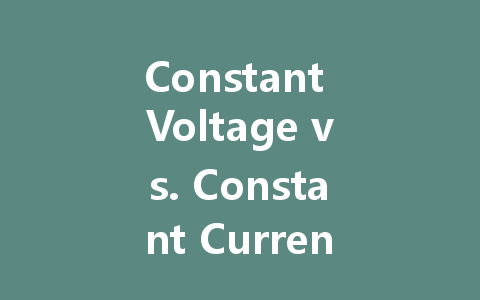When it comes to powering LED lights, one of the most pivotal decisions you will face is whether to use a constant voltage or a constant current power supply. Both options have their unique advantages and applications, making it essential to understand their differences, benefits, and ideal usage scenarios. In this article, we will delve into the nitty-gritty of these two driving methods to help you choose the best solution for your LED lighting needs.
Understanding Constant Voltage Power Supplies
A constant voltage (CV) power supply maintains a steady voltage output regardless of the load’s current demand, up to its specified current limit. This configuration allows LEDs to be connected in parallel, making it suitable for applications like LED strips and ceiling lights where consistent brightness is crucial.
Benefits of Constant Voltage Power Supplies
Exploring Constant Current Power Supplies
On the other hand, constant current (CC) power supplies provide a fixed current to the LEDs, regardless of the load’s voltage demands. This makes them particularly well-suited for driving individual LEDs or series strings of LEDs where consistent brightness is essential for performance.
Benefits of Constant Current Power Supplies
Diferencias clave entre tensión constante y corriente constante
Understanding the core differences between these two types of power supplies can dramatically influence your decision-making process.
Regulación de tensión vs. corriente
Ideal Use Cases
Making the Right Choice: Factors to Consider
When deciding between a constant voltage and constant current power supply, consider the following factors:
Requisitos de solicitud
Analyze the specific requirements of your lighting project. Will you be operating multiple LED fixtures? Do you require precise brightness control? Understanding the functional needs will guide your decision effectively.
Budget Constraints
Constant voltage power supplies tend to be more cost-effective, but if your application requires the specific benefits of a constant current setup, it may justify the additional expense.
Future Upgrades
Consider the potential for future upgrades to your lighting system. A constant current power supply may offer more flexibility if you plan to expand or modify your setup in the future.
Conclusión
Choosing between a constant voltage and a constant current power supply for LED lights is an important decision that will impact both performance and cost. Understanding the benefits, drawbacks, and specific applications of each type can empower you to select the right solution for your project. Ultimately, it’s crucial to weigh factors such as application requirements, budget constraints, and future scalability to arrive at the best choice for your LED lighting needs. Whether you opt for constant voltage or constant current, you’ll be one step closer to achieving optimal lighting performance!
